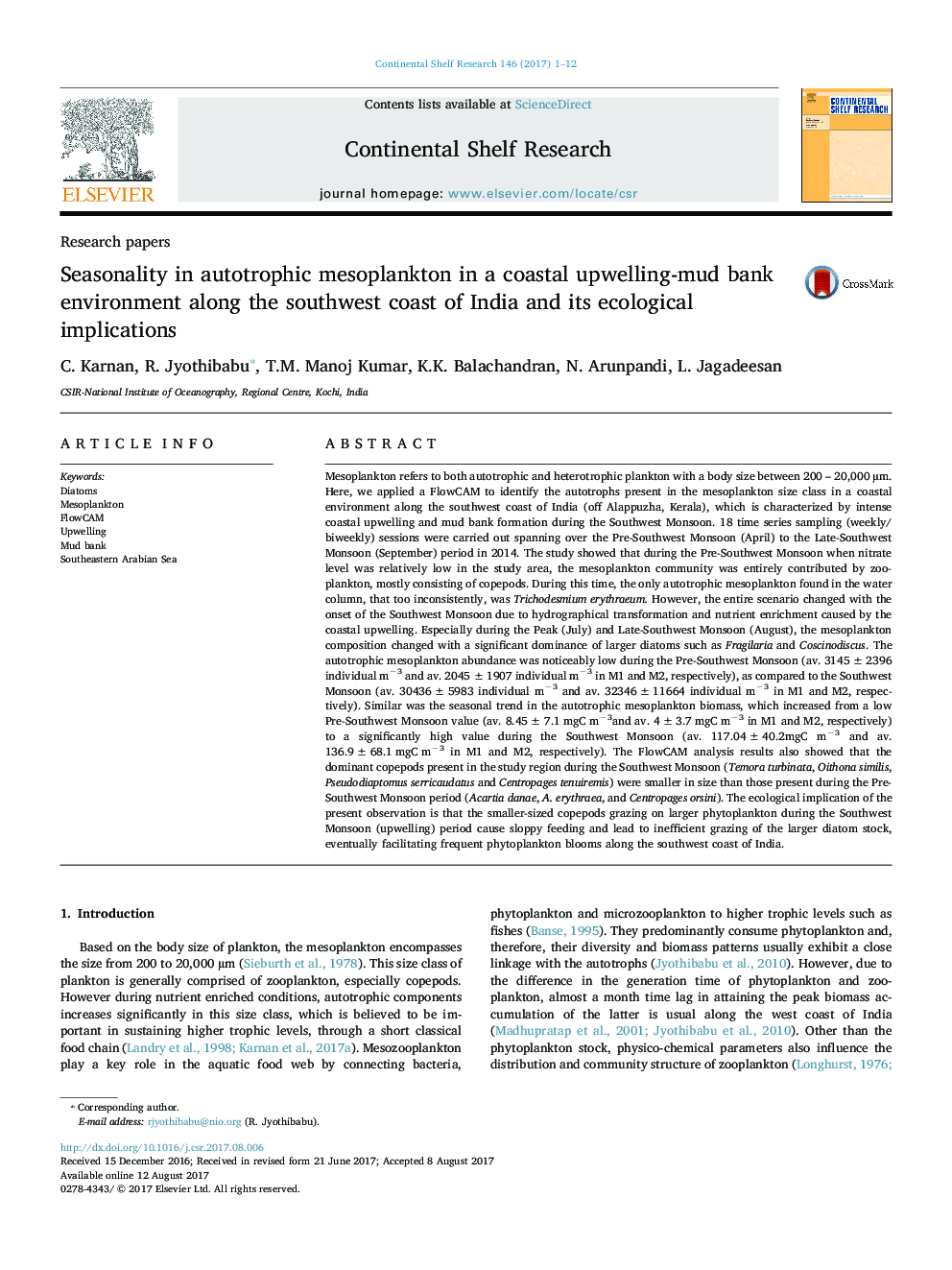| کد مقاله | کد نشریه | سال انتشار | مقاله انگلیسی | نسخه تمام متن |
|---|---|---|---|---|
| 5764435 | 1626067 | 2017 | 12 صفحه PDF | دانلود رایگان |

- Noticeable seasonality exists in the autotrophic mesoplankton along the southwest coast of India.
- Autotrophic mesoplankton increased significantly during the coastal upwelling period.
- Copepods during the upwelling period were smaller as compared to the non-upwelling period.
- Smaller copepods are inefficient to control large diatoms during the upwelling period.
- This facilitate frequent phytoplankton blooms during the Southwest Monsoon (upwelling) period.
Mesoplankton refers to both autotrophic and heterotrophic plankton with a body size between 200 - 20,000 µm. Here, we applied a FlowCAM to identify the autotrophs present in the mesoplankton size class in a coastal environment along the southwest coast of India (off Alappuzha, Kerala), which is characterized by intense coastal upwelling and mud bank formation during the Southwest Monsoon. 18 time series sampling (weekly/biweekly) sessions were carried out spanning over the Pre-Southwest Monsoon (April) to the Late-Southwest Monsoon (September) period in 2014. The study showed that during the Pre-Southwest Monsoon when nitrate level was relatively low in the study area, the mesoplankton community was entirely contributed by zooplankton, mostly consisting of copepods. During this time, the only autotrophic mesoplankton found in the water column, that too inconsistently, was Trichodesmium erythraeum. However, the entire scenario changed with the onset of the Southwest Monsoon due to hydrographical transformation and nutrient enrichment caused by the coastal upwelling. Especially during the Peak (July) and Late-Southwest Monsoon (August), the mesoplankton composition changed with a significant dominance of larger diatoms such as Fragilaria and Coscinodiscus. The autotrophic mesoplankton abundance was noticeably low during the Pre-Southwest Monsoon (av. 3145 ± 2396 individual mâ3 and av. 2045 ± 1907 individual mâ3 in M1 and M2, respectively), as compared to the Southwest Monsoon (av. 30436 ± 5983 individual mâ3 and av. 32346 ± 11664 individual mâ3 in M1 and M2, respectively). Similar was the seasonal trend in the autotrophic mesoplankton biomass, which increased from a low Pre-Southwest Monsoon value (av. 8.45 ± 7.1 mgC mâ3and av. 4 ± 3.7 mgC mâ3 in M1 and M2, respectively) to a significantly high value during the Southwest Monsoon (av. 117.04 ± 40.2mgC mâ3 and av. 136.9 ± 68.1 mgC mâ3 in M1 and M2, respectively). The FlowCAM analysis results also showed that the dominant copepods present in the study region during the Southwest Monsoon (Temora turbinata, Oithona similis, Pseudodiaptomus serricaudatus and Centropages tenuiremis) were smaller in size than those present during the Pre-Southwest Monsoon period (Acartia danae, A. erythraea, and Centropages orsini). The ecological implication of the present observation is that the smaller-sized copepods grazing on larger phytoplankton during the Southwest Monsoon (upwelling) period cause sloppy feeding and lead to inefficient grazing of the larger diatom stock, eventually facilitating frequent phytoplankton blooms along the southwest coast of India.
Journal: Continental Shelf Research - Volume 146, 15 August 2017, Pages 1-12